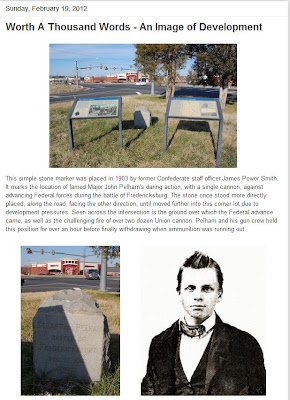
Cummings has a knack for ferreting out interesting stories, and I especially enjoy his astute observations on period photographs and drawings, and his skillful, Frassinito-esque camera work. lining up angles long disguised by modern sprawl. Take a look at this nifty blog entry regarding a May 9, 1864 sketch by Alfred Waud.
I am glad to see Spotsylvania given such passionate attention, since it is one of my favorite periods to study in the Overland Campaign. I wrote my last major college paper on the battle, and I cringe to think that a copy of that paper may survive in a file drawer somewhere. It was for an independent study course, the last four credits needed to get my B.A. in History, and had I known then what I know now, I would not have attempted to write anything meaningful about such a large, long, and complicated affair.
Once I delved into it, I was quickly in over my head, but had invested too much time and trouble in the project to reverse course. In the end, I produced a reasonably sourced semblance of a battle narrative, marred by occasional tangles of impenetrable confusion. Suffice it to say, Spotsylvania kicked my ass and left me bleeding, but I lived to fight another day, unlike so many thousands of poor souls who perished there. The eminent Professor Jaebker was generous, and gave me an A for effort, though his red-ink critiques filled the margins of every page.
Sometime later I learned that my mother's great-grandfather, Francis Marion Kirby of the 5th Wisconsin, was shot in the knee there. The 5th Wisconsin was selected for Emory Upton's bold and ill-fated assault on the salient on May 10, and it seems likely that he got his wound in that action. I wrote about one of my visits to Fredericksburg in this old post from 2006.
 |
| Jed Hotchkiss map of Spotsylvania, Library of Congress |
I'm still learning what happened at Spotsylvania, after all these years, because like the war itself, the story is just that big. Given my experience with Dr. Jaebker, I am greatly impressed by the work of historians like Gordon Rhea, and William D. Matter, and feel gratitude that they took the time to sort it all out in proper fashion.
No comments:
Post a Comment